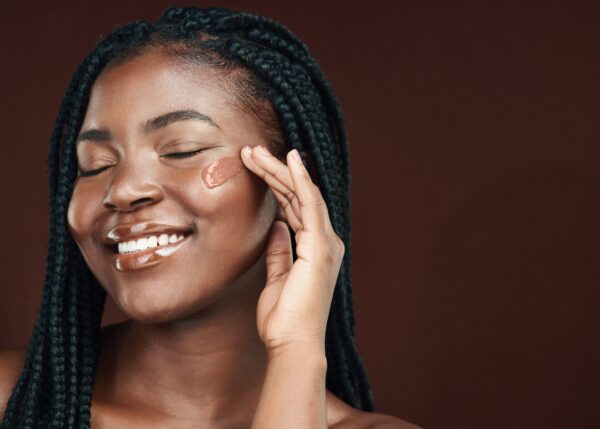Credit: Petar Chernaev/E+/Getty Images
Sunscreen is having a “glow up,” a social media term that means makeover or transformation. Serum–like formulas, tints that better match your skin tone and multitasking treatment sunscreens are just some of the high–tech options now. Our experts provide intel on the latest innovations to help shield your skin from the sun.
If you could prevent breast cancer by wearing something protective, you’d do it, right? Well, the powerfully effective sunscreens on the market today can prevent the DNA damage that can lead to skin cancer. But for many people, especially the younger generation, the potentially debilitating and even deadly disease seems like a far-off and unlikely threat. So, how do we motivate people to wear sunscreen regularly? It’s a question that dermatologists and sun-care brands have grappled with for years. After careful tracking of consumer behavior and trends, they are learning that the answer is — beauty! Turns out that using sun protection regularly helps keep your skin looking its youngest and most vibrant. In a way, it’s the fountain of youth.
Yes, that means signs of sun damage — wrinkles, brown spots, broken blood vessels, enlarged pores, etc. — and the preventive powers of sun protection. “I tell my patients who are spending a lot of time and money on lasers to get rid of sun damage and neurotoxins to reduce wrinkles that if they wear sunscreen every day, they’re preventing a lot of that damage in the first place,” says New York City dermatologist and Mohs surgeon Elizabeth K. Hale, MD. It also means sneaking ultraviolet (UV) filters into trendy, pretty and cosmetically elegant products that don’t feel like sunscreen. Because experts know the best sunscreen is the one you’ll wear daily. Featherweight, serum-like formulas, more inclusive tint ranges and makeup with SPF for oft-neglected areas are just some of the innovations we’re seeing. Bonus: These high-tech options are tracking with younger people and on social media, which may mean fewer skin cancers in the future.
Sunscreen Is Trending
While social media can spread some bad skin-care advice (DIY sunscreen? Do not try that at home), there’s been a bright spot for skin cancer prevention: more attention on products that contain sunscreen. And it seems Gen Z-ers (those born between 1997 and 2012) are getting the message. According to the research firm NPD, Gen Z consumers between the ages of 13 and 24 prefer brands endorsed by a physician. Plus, a beauty report from Kyra, a global creator company that connects brands and influencers, noted that skin care is Gen Z’s biggest priority, with sunscreen ranking number two in products they can’t live without in their daily routine.
Dr. Hale and her sister, dermatologist Julie K. Karen, MD, who similarly specializes in Mohs surgery and cosmetic dermatology, practice together at CompleteSkinMD on the Upper East Side of Manhattan. They both have tweens who are “obsessed” with skin care, which they credit to the power of social media. (Having dermatologist moms may have something to do with it, too.) “While it’s not necessarily the hottest topic for this age group, I think there’s an opportunity to utilize social media and influencers to educate young people about the importance of sun protection,” says Dr. Hale.
“As dermatologists,” Dr. Karen chimes in, “we worry about social media spreading false information and kids having reactions from irritating products. But teaching younger people safe sun habits is always a good thing.”
The “Skinification” of Sun Care
The term “skinification” means using skincare ingredients in other categories such as hair care. And while sunscreen has always been made for your skin, it’s getting more sophisticated in terms of formulations, blurring the lines between what’s a skin-care product and sun protection. “You can get everything in one now — moisturizing ingredients, antioxidants and repair enzymes — with a pretty high SPF level, which makes it easy to multitask,” says Dr. Hale. She prioritizes sunscreens that contain antioxidants to offer protection against free radicals, which are unstable oxygen molecules created by UV exposure that attach to healthy cells, causing damage. Research supports topical antioxidants such as vitamins C and E for neutralizing free radicals, and studies have shown they’re even more effective when combined. Dr. Hale also likes sunscreens that include niacinamide, an antioxidant that also helps hydrate and reduce inflammation in the skin.
Dr. Karen cites another important trend in sunscreen ingredients: DNA repair enzymes. “These are enzymes such as photolyase and superoxide dismutase that recognize and repair DNA damage immediately,” she explains, “so it doesn’t accumulate or progress into skin cancer.” The mechanism is different from that of antioxidants, which work by neutralizing the free radical before it does damage to your DNA.

Hyperpigmentation — dark patches of skin caused by sun exposure — can be a concern for people of color. Daily sunscreen, now tinted in a broader range of shades, can help minimize the issue. Credit: Jay Yuno/E+/Getty Images
Better-Feeling Formulas
Sunscreens used to have a reputation for being thick, goopy and greasy. That has changed. Now there are ultralight formulations, silky sunscreen oils, serums and gel-based options available, ideal for those with oily or acne-prone skin. “These formulas are not necessarily treating acne, but they can be noncomedogenic, which means they’re not going to inflame and aggravate your acne,” says Dr. Karen. And it’s not just beauty-savvy teens and women gravitating toward these skin-friendly formulas. “Men typically don’t like the feel of a creamy moisturizer, so gel and oil-free formulations may appeal to them more than lotions,” she says.
So, how do cosmetic and sun-care brands make products feel nicer on your skin? Rhonda M. Davis, a cosmetic chemist who works in product development in Mobile, Alabama, and is highly sought by the media for her insight on consumer goods, points to SPF boosters and enhancers, ingredients added to sunscreen products to make them more effective and improve the formula’s wear and feel. The boosters are powders and filler ingredients coated with active ingredients in sunscreens that meet FDA regulations. Chemists then combine them with “plant-based, silicone-like materials” to make the formula glide on better and feel silky on your skin. To the naked eye, these powders look like, well, powder, but under a microscope they take different shapes that work to enhance the finish and feel. “Some are spherical and give consumers a soft, airbrushed look, while others are flat and more saucer-shaped, like blood platelets, which make the product adhere to skin better,” says Davis.
The feel of a product and its performance are important to athletes and outdoor enthusiasts, who say their sunscreen sweats off too quickly. “The real innovation has been better film-forming polymers, which help the sunscreen adhere to the skin,” says Perry Romanowski, a Chicago-based cosmetic chemist, renowned sun-care industry expert and founder of the blog Chemists Corner, where he breaks down important concepts and ingredients in cosmetic formulations. These polymers can also help eliminate that greasy feel, he says. Davis is particularly excited by a globally approved, natural, film-forming polymer that’s environmentally friendly and nontoxic to aquatic life but also performs like leading synthetic polymers.
The top of your head takes a beating from the sun, too, and now there are better formulas to protect it accordingly. “Your scalp is exposed every day, so people with thinning hair and men with no hair have a high rate of scalp squamous cell carcinoma, a skin cancer most correlated with chronic, cumulative sun exposure,” says Dr. Karen. While hats offer the best coverage, there are now targeted scalp sunscreens that don’t leave hair greasy. Look for formulas with broad-spectrum sunscreen in them. (Hint: You’ll see the FDA drug facts box on the label.) There are also hair products that contain other UV filters designed to prevent your hair color from fading in the sun, but these won’t do anything to protect the skin on your scalp.
Makeup Made Better
Makeup with sun protection is not new. It’s more common than not to see a foundation that lists an SPF number and/or broad-spectrum protection on the label. The UV filters in your makeup are the same ones you’ll find in your beach sunscreen, but dermatologists caution against using makeup with SPF as your sole source of skin protection. “It’s always been a pet peeve of ours, because we know you’re not applying enough makeup to get meaningful protection,” says Dr. Hale. (For your face, the recommendation is a nickel-sized amount — a lot of foundation.) So, apply your regular sunscreen or moisturizer sunscreen first. Then apply your makeup with SPF as a bonus or try tinted or translucent sunscreen powders to reapply throughout the day.
However, dermatologists are excited by makeup with sun protection for two key areas most people skip with traditional sunscreen: lids and lips. New cream and powder eyeshadows formulated with sunscreen can help protect delicate eyelid skin (an estimated 5 to 10 percent of skin cancers occur on eyelids). For lip protection, Dr. Hale suggests swiping on lip color with SPF 30 or higher to shield thin lip skin. “Lip gloss that doesn’t contain SPF is like applying baby oil to your lips,” she says. Most pigmented lipsticks provide at least some physical protection from UV rays.
Tinted sunscreens, which many people use in place of a traditional foundation, have evolved, too. The earliest versions offered one universal shade that wasn’t universally flattering or had a limited selection — think light, medium and dark. We’re now seeing broader shade ranges with as many as 20 options to match various skin tones without the ashy, white cast on dark skin tones. “If you shrink the size of the zinc oxide particles small enough (what’s known as micronized zinc), you can get a good dispersion and reduce the whitening effect,” says Romanowski.
Iron oxides, minerals that give tinted formulas their color, aren’t purely cosmetic, either. A recent study in the Journal of Cosmetic Dermatology showed that iron oxides enhance protection against blue light, especially when combined with zinc oxide. “We know that blue light contributes to melasma and other pigmentary disorders, so a tinted sunscreen provides an added layer of protection for at-risk individuals,” says Dr. Karen. Blue light is emitted by the sun, fluorescent lighting and from electronic devices, including your computer and smartphone. That’s another good reason to wear your sunscreen every day.
Changing the Game
We’ve long known sunscreen works to prevent sunburn, sun damage and skin cancers, but getting people to wear it regularly has always been the challenge. By making formulas that multitask, feel good on your skin and are more inclusive of all skin tones, we’re getting closer to our goal of making sun protection a daily habit. And that’s a thing of beauty!





